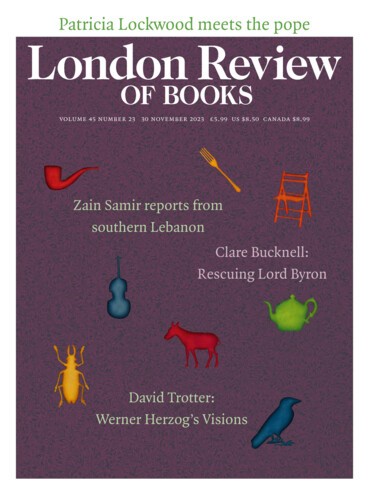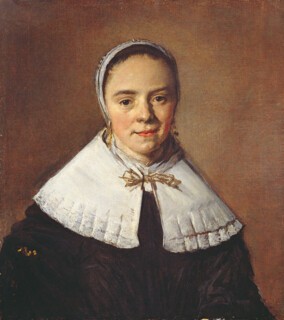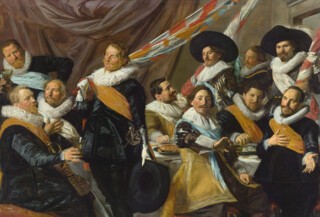Whatever the Laughing Cavalier is so pleased about, I’ve no wish to know. That bumptious bar-room menace from the Wallace Collection has me taking to my heels. I gravitate instead towards a black-hatted roué from the Fitzwilliam, more at ease with his slouch and sad wry smile. Elsewhere in the National Gallery’s Frans Hals exhibition (until 21 January), a debonair 12-year-old in a family group from Madrid looks up and away from dad, who is busy rolling bedroom eyes at mum, his demure elder sister and the household’s glum African servant boy. The boy’s demeanour reads I can just about take this, while the dreams of the future heir drift airily, as yet unruffled. Each holds me; I warm to them. But it is the quiet young woman loaned by the Ferens Art Gallery in Hull whom I’d most like to know. She surely gave Philip Larkin the cue when he wished for a friend’s newborn daughter to be neither ‘ugly nor good-looking/Nothing uncustomary’, but bent on that ‘unemphasised, enthralled/Catching of happiness’ that sustains a well-lived life.
Encounters are Hals’s business. He is a host: clients come to his studio door and he ushers them in and on – to us, the viewers, and to a flattering mirror. He foists on them positivity: let happiness be caught. Come on, chin up, cock your arm – fist to hip, ‘Renaissance elbow’ outwards – and project! He grins, and they grin back. Often he offers them a platform to perch on and with it clear advantage. Now, don’t you feel good? And so, for some fifty years from the 1610s, the burghers of Haarlem rose to the occasion and thrust themselves forwards, as swaggeringly as they could manage. Four centuries on, am I pleased to meet them thus? Not much, in many cases. So often Hals’s portrait subjects seem all too up for this charade, insufferably brash and loud. But it’s like any party: individuals are various, you hunt for those you get on with.
On what level, though, do I meet their host? In a sense, he’s self-effacing: he speaks second person, forever exclaiming you! Other humans are what he cares for, and nothing could matter more. A pompous nouveau riche; a ragged fisher-boy; that African lad and a jester in blackface; a crazy old lady in the local and a posh little girl’s impeccable young nurse: he does his utmost to catch every eye and achieve an understanding. From which, I read decency into Hals. The prevailing smiliness suggests he’s been venturing wisecracks. But if they fail to laugh, he’s still there for them. Let the world fall away – indeed, there is almost no over-and-beyond in the art of Hals, who likely leaned on a colleague for the landscape surrounding that family from Madrid – but the need to attend remains. These paintings are status symbols rather than devotional aids, yet Christian notions of the soul underpin them.
But then, the pizzazz accrues both to client and producer. You have chosen the flashiest studio in town – Haarlem having a number of portraitists on offer – and your choice helps advertise a business that aims no more, perhaps, than to stay afloat. It is hard to read large ambitions into the career presented in Steven Nadler’s recent biography of Hals, The Portraitist (Chicago, £28). Its protagonist scurries from one rental to another around the busy cloth-trade city, incessantly juggling his debts, until the 1660s, when the burgomasters are recorded making winter fuel payments to an indigent town worthy. Hals’s one significant excursion – to Antwerp, for some months in his early thirties – seems a marker of his self-positioning. His family had come from there: he would stake himself out as the Fleming among those exactingly descriptive northern Netherlanders, a painter louder and more flamboyant, offering a glint of Rubens stardust.
Hals’s flash is the flash of the passing moment. He has an unsurpassed grip on what’s transitory: smiles, cackles, a boy sticking out his tongue, a man tilting his chair so far back that he’s just about to fall over. His art is a stand-out instance of that taste for the snatched impression that ran from Caravaggio, circa 1595, painting a boy startled by a lizard’s bite, to Velázquez, circa 1655, painting the whizz of a spinning wheel. I gawp at the sleight of hand involved. In 17th-century Dutch studios, you worked in at least two stages. First, you structured your image tonally, in an earth pigment monochrome. Then over this ‘dead colour’ you brought in your hues progressively, finally capping them with highlights. You’d need to allow an interval for the monochrome to dry, or else your reds and blacks would end up not bright but sludgy. Hals’s technical trick, so far as I can make out, was to collapse that interval by brushing the dead colour in a dryish stiff impasto and the live colours in lushly liquid oils – with the result that the whole image could coalesce in a single brisk session. This means that he can bypass the sag and drag that sitters’ faces are prone to, and the forlorn hope of getting them to re-enact expressions. At points, his overpaints move like the ‘live’ mode on an iPhone camera, scooting over appearances for a three-second slither.
As a comparator to this act, cross over to the National Gallery’s Rembrandt rooms. There you meet a puzzler and a fretter, a draughtsman of driven, explorative scribbles, a yearner for what’s beyond. Against that, Hals can be seen tackling things not by line, but by masses and swipes – quickfire serried whisks of the brush, surehandedly registering whatever light gleams on flesh, hair or fabric. Hals doesn’t draw. Indeed, Hals doesn’t think. He knows. His comprehension of heads and hands, of the way they fold back on themselves, is consummate. He alerts you to the shadows that eyelashes cast on the bridge of a nose and to the deep dark pools opening up, once palms are crumpled for the sake of those shoved-forward elbows. Just how Hals acquired this rounded understanding and the bravura handling with which he deployed it are questions without certain answers. The show’s opening portraits – of a grouchy grandee and his no less guarded wife – betray not the slightest hesitancy. Dating from around 1612, the year Hals turned thirty, they are among the earliest pieces of his now known.
The exhibition, then, presents less an artistic progress than a succession of encounters. Nadler’s biography offers no great twists or turns either. Its author, a judicious and affable scholar, finding the life itself just a little elusive, devotes himself extensively to the times. He has much to say about guild regulations and the ups and downs of the Dutch economy. Nonetheless there is a gradual imaginative shift to which Nadler attends, one with tangential political connotations. Head painting in Holland, when Hals entered that trade, came, as it were, with or without the definite article. There were big somebodies who asked you to immortalise their likenesses, but there were also generic personalities – entertainers, flavoursome lowlifes, sweet little kids – whose images were good to liven up interior décor. Initially Hals reserved his hog-brush hack and slash – the rouw handling, as contemporaries termed it, the ‘rough style’ – for the latter category, the so-called tronie. VIP faces would be rendered with the same punctiliousness as their cartwheel ruffs and the gold-braid stitching on their velvets. But as his reputation firmed up, Hals took liberties. It turned out that patricians and commodity traders could also enjoy being caught in paint fights. And as he grew older, he pushed his luck further: a 1645 portrait of the fashionista Jasper Schade, one of his boldest, speediest action paintings, has a near satirical edge. It was this co-ordination of open brushwork with raised chins and cocked elbows that caused republicans, two centuries later, to seize on Hals anew. For the likes of Manet, here was the look of liberté.
In a 1904 essay, Alois Riegl built on that interpretation. Present Hals with eleven proud burghers – as in his Banquet of the Officers of the St George Civic Guard, painted around 1627 – and he arranges their interactions, Riegl argues, so as to abolish ‘subordination’. But somehow the power to see that has gone. Or if this more than eight-foot-wide canvas delivers égalité, that principle amounts to no more than defensive containment. Hals may not be ambitious, but his clients are, and it’s his task to corral them. He struggles a bit – witness the contrived matching arm-sweeps of the officers on the far left and far right – but he wrests from the challenge a concerted blare of hot (and symbolically royalist) orange sashes, within a clatter of jagged forms: just as the brushwork is bristly and discontinuous, so the couture of the era, angular and accessory-cluttered, seems to contradict the bodies beneath. Of Hals’s non-ambition, the handsomest record – thanks to the painter Pieter Codde, who took it out of his hands – is the so-called Meagre Company, a sixteen-man, fourteen-foot-wide commission from another civic militia, this time based in Amsterdam. Hals seems to have abandoned it halfway through because the ten-mile journey from home was proving too tiresome. Devil-may-care was his default mode and Nadler is overly prudent when he baulks at hearsay about Hals’s booziness. It feels unmistakable to me: beer and chasers, this exhibition fairly reeks of them.
Bring the numbers down to two and Hals, whose Lysbeth accompanied him through every change of address, is more completely in his element. The variety of conjugal dynamics tickles him. In one pair of canvases that the curators have reunited we see both husband and wife pose with arm akimbo: but it is she, Cunera van Baersdorp, who stands rock-like, firm and pivotal while her Michiel de Wael supplies the compass’s moving foot, whirling round giddily to face us in another bravura kapow! As well as the let’s-get-it-on of the father from Madrid (whose matronly wife cautiously returns his stare) there is the cat-that-got-the-cream afterglow shared, in a loan from the Rijksmuseum, by a well-heeled young businessman and his wife, again posing before some other painter’s landscape background. Hals, Mr Immediacy, had no truck with storytelling and little with symbolism – another portrait of the same trader once sported allegories of Envy and Envy’s enemy, Death – whoever overpainted them probably did the canvas a favour. But if you had pushed Hals for a thought about his agenda, he might well have plumped for happiness-catching, such as we see in that dual portrait. Or in the numerous tronies on show at the National Gallery – merry musicians, cheery children and so on. His oeuvre, Nadler suggests, ‘may contain more laughs and smiles than that of any other painter in history’.
This puts the viewer on the spot. Is it churlish not to smile back? But happiness won’t be blowtorched: to grow that flame you need kindling. It sparks in little gaps and catches in sideways leaps. In the National Gallery’s own Young Man Holding a Skull, death’s emblem is quite as joyous, in its dozen-brushstroke sprint into solidity, as the swanky ostrich plume in this actor’s cap. More than his parted rosy lips, it is the shock of his foreshortened outstretched fingers that invigorates. Spaces between – eye-sockets, dark palms – offer charge points for the viewer who wants to draw power. Those intervals expand. The octogenarian nailing down the six Regents of the Old Men’s Alms House in 1664 is no longer concerned with corralling or composition. He merely faces you, you, you, you, you and you within a big dark space. His hand is near tremulous, but his mind’s grip has sharpened. We are in something more like a world.
Send Letters To:
The Editor
London Review of Books,
28 Little Russell Street
London, WC1A 2HN
letters@lrb.co.uk
Please include name, address, and a telephone number.



